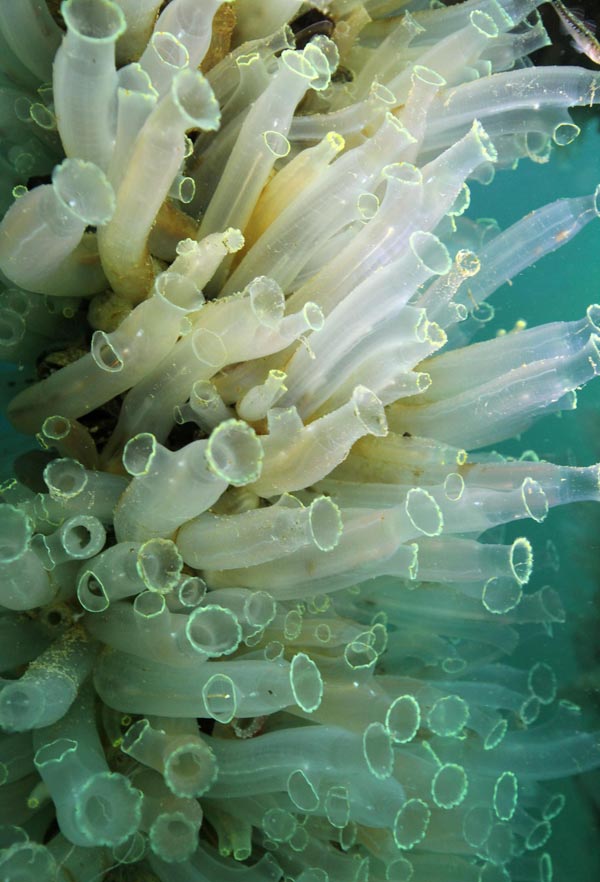Human transport has unpredictable genetic and evolutionary consequences for marine species

Ciona intestinalis. Credit: 'Station Biologique Roscoff / Wilfried Thomas'.
The research, published in the journal Biology Letters, says that human forms of transport can disrupt natural genetic patterns that have been shaped over long periods of time. This has unknown consequences for both native and invasive species.
Lead author and PhD Student Jamie Hudson said: “Marine species are expected to develop populations whereby geographically close populations are more genetically similar than geographically distant populations. However, anthropogenic (environmental change caused by humans) activities such as shipping promote the artificial transport of species and bring distant populations together, leading to the crossing of individuals and therefore genetic material. The disruption of pre-modern genetic patterns through anthropogenic activities is an unprecedented form of global change that has unpredictable consequences for species and their native distributions.”
The researchers investigated the genetics of a native marine invertebrate species (the tunicate Ciona intestinalis) in the English Channel, an area with a high prevalence of shipping. Ciona intestinalis has restricted dispersal capabilities and is most often reported in artificial habitats, such as marinas, so are therefore readily transported by human activities.
They collected specimens between June and December 2014 from 15 different locations on the English and French coasts. They looked at sections of DNA called microsatellites (areas of DNA that contain repeating sequences of two to five base pairs), which can be read and can help determine how similar populations are to each other.
They found a mosaic of genetic patterns that could not be explained by the influence of natural or anthropogenic means alone.
Jamie, who is based in the Ecology and Evolution Lab, added: “We found that C. intestinalis from some locations exhibited a shuffling of genetic material, as expected by human-mediated transport (boats can travel further distances than the larvae). However, unexpectedly some of the populations exhibited the opposite pattern (some populations were not genetically similar), despite there being evidence of artificial transport between these locations – this may be due to natural dispersal or premodern population structure.
Taken together, the authors found dissimilar patterns of population structure in a highly urbanised region that could not be predicted by artificial transport alone. They conclude that anthropogenic activities alter genetic composition of native ranges, with unknown consequences for species' evolutionary trajectories.
The research was conducted by Jamie, under the supervision of Dr Marc Rius from the University of Southampton, and Dr. Frédérique Viard and Charlotte Roby at the Station Biologique de Roscoff, in France. This study was funded by the ANR project HYSEA and the University of Southampton.
Media Contact
All latest news from the category: Life Sciences and Chemistry
Articles and reports from the Life Sciences and chemistry area deal with applied and basic research into modern biology, chemistry and human medicine.
Valuable information can be found on a range of life sciences fields including bacteriology, biochemistry, bionics, bioinformatics, biophysics, biotechnology, genetics, geobotany, human biology, marine biology, microbiology, molecular biology, cellular biology, zoology, bioinorganic chemistry, microchemistry and environmental chemistry.
Newest articles

“Nanostitches” enable lighter and tougher composite materials
In research that may lead to next-generation airplanes and spacecraft, MIT engineers used carbon nanotubes to prevent cracking in multilayered composites. To save on fuel and reduce aircraft emissions, engineers…

Trash to treasure
Researchers turn metal waste into catalyst for hydrogen. Scientists have found a way to transform metal waste into a highly efficient catalyst to make hydrogen from water, a discovery that…

Real-time detection of infectious disease viruses
… by searching for molecular fingerprinting. A research team consisting of Professor Kyoung-Duck Park and Taeyoung Moon and Huitae Joo, PhD candidates, from the Department of Physics at Pohang University…





















